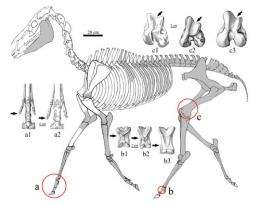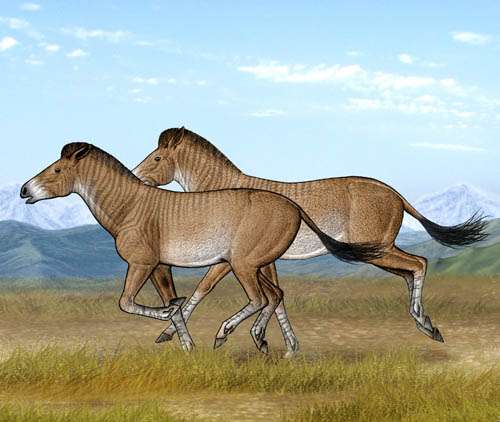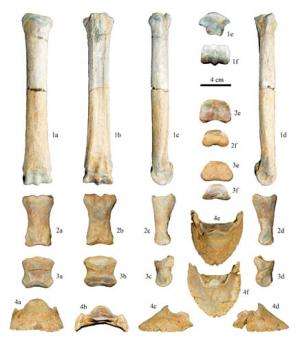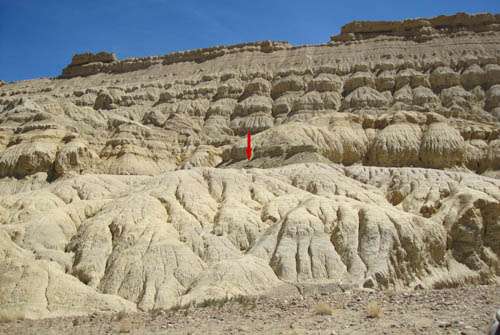Three-toed horses reveal the secret of the Tibetan Plateau uplift

The Tibetan Plateau is the youngest and highest plateau on Earth, and its elevation reaches one-third of the height of the troposphere, with profound dynamic and thermal effects on atmospheric circulation and climate. The uplift of the Tibetan Plateau was an important factor of global climate change during the late Cenozoic and strongly influenced the development of the Asian monsoon system. However, there have been heated debates about the history and process of Tibetan Plateau uplift, especially elevations in different geological ages.
In PNAS Early Edition online April 23, 2012, Dr. Tao Deng from Institute of Vertebrate Paleontology and Paleoanthropology, Chinese Academy of Sciences, and his team report a well-preserved skeleton of a 4.6 million-year-old three-toed horse (Hipparion zandaense) from the Zanda Basin, southwestern Tibet. Morphological features indicate that the Zanda horse was a cursorial horse that lived in alpine steppe habitats. Because this open landscape would be situated above the timberline on the steep southern margin of the Tibetan Plateau, the elevation of the Zanda Basin 4.6 Ma ago was estimated to be ~4,000 m above sea level using an adjustment to the temperature in the middle Pliocene as well as comparison with modern vegetation vertical zones. Thus, Deng and his team conclude that the southwestern Tibet achieved the present-day elevation in the mid-Pliocene.
Fossils of the three-toed horse genus Hipparion that have been found on the Tibetan Plateau have provided concrete evidence for studying the uplift of the plateau, including a skull with associated mandible of Hipparion zandaense from Zanda. In August 2009 a three-toed horse skeleton was excavated from the Zanda Basin, and its dental morphology confirmed the assignment to H. zandaense.
The Zanda Basin is a late-Cenozoic sedimentary basin located just north of the high Himalayan ridge crest in the west-central part of the orogen (32° N, 82° E). The Sutlej River has incised through to the basement, exposing the entire basin fill in a spectacular series of canyons and cliffs. The horse skeleton was discovered in the eastern bank of the main wash of Daba Canyon west of the Zanda county seat and south of the Sutlej River.
Because both morphology and attachment impressions on fossilized bones can reflect muscular and ligamentous situations, they can provide evidence for the type of locomotion that extinct animals used when they lived. The skeleton of the Zanda horse preserved all limb bones, pelvis, and partial vertebrae, which provide an opportunity to reconstruct its locomotive function.

A greatly hypertrophied medial trochlear ridge (MTR) of the femur serves to “snag” the medial patellar ligament, or parapatellar cartilage, and the patella when the knee joint is hyperextended, forming a passive stay-apparatus or “locking” to reduce muscular activity in the knee extensors during long periods of standing. The well-developed MTR is an indicator of the presence of this locking mechanism. The femur MTR of the Zanda horse is greatly enlarged relative to the lateral trochlear ridge. Like modern horses, which may stand erect for over 20 hours a day, even in their sleep, the Zanda horse could remain on feet for long periods of time without fatigue. On the other hand, the forest three-toed horses, such as the European Hipparion primigenium, have an obviously smaller femur MTR than the Zanda horse.
Gracile limb bones are a marker for cursorial ability, which is most clearly exhibited on metapodials of ungulates. The gracility of the metapodial shaft is represented by diminished breadth relative to its length. The ratio between the maximum length and the minimum breadth indicates that the Zanda horse and the extant Tibetan wild ass have relatively slender metapodials, while the forest horses have very robust metapodials.
During the evolution of increased cursoriality in horses, the posterior shifting of the lateral metapodials relative to the third metapodial is not only an evolutionary change toward functional monodactyly, but also a better adaptation for running, usually accompanied by a deepening of the whole bone and an effacement of the distal supra-articular tuberosity. As a result, the width of the distal tuberosity appears reduced relative to the articular width in the Zanda horse, whereas the former is larger than the latter in the forest horses.

The well-developed sagittal keel on the distal extremity of the metapodial is another character to enhance pendular movement of limb bones, and an adaptation for running. The development of the keel is relative to the deepening of the distal lateral groove, and is accompanied with the thickening of the medial condyle. These changes diminish lateral mobility and create better conditions for anteroposterior movements. The sagittal groove of the first phalanx III contains the keel of the distal articulation of the metapodial in order to avoid dislocation and sprain of the joint in lateral orientation, especially during rapid turning. The Zanda horse has a strong keel, so it can better minimize the lateral movement of the foot articulation, thereby strengthening the anteroposterior movement more effectively.
In three-toed horses, the increase in size of the oblique ligaments on the proximal and central phalanx may have allowed the central toe to stand more vertically, thus causing the side toes to be lifted from the ground and become non-functional in locomotion, allowing the animal to run faster by supporting the fetlock and by adding bounce. The Zanda horse has strong oblique ligaments, more similar to Equus, the modern horse. In three-toed horses, each foot has three toes (digits II to IV); digits I and V are absent. The reduction of the side toes (digits II and IV) in horses is a marked evolutionary trend towards better running ability. The central toes of the Zanda horse are relatively long, but the side toes are distinctly reduced so that they have a larger suspending extent. This character indicates that the side toes of the Zanda horse have completely lost locomotive function, a characteristic related to faster running.
If distal elements of a limb are lengthened relative to proximal ones, the whole limb will be lengthened while keeping its center of mass situated proximally and reducing its inertia, which allows for a long, rapid stride, and speed is the product of stride length and stride frequency. Lengths of distal elements of fore- and hindlimbs, i.e., metapodials and first phalanges, relative to proximal elements in the Zanda horse are much longer than in the forest horses, which indicates the stronger running ability of the former.

The locomotive function shows that the Zanda horse has the ability to run fast and stand persistently, which is beneficial only on open habitats, because close forests would encumber running. Three-toed horses are typical hypsodont ungulates, and the tooth crowns of the Zanda horse are especially high, which indicate that it is a grass-grazing specialist. Because grazing is inefficient in terms of nutritional intake, a great amount of food is required to obtain adequate nutrients. Grazing horses spend a large portion of the day standing and eating in open habitats with mainly herbaceous plants, so that they can keep watch for potential predators. The well-developed MTR of the femur in the Zanda horse is a fitting adaptation for this ecosystem. The vestigial side toes of the Zanda horse also reflect its adaptation for open environments instead of forests.
The Tibetan Plateau has gradually risen since the Indian plate collided with the Eurasian plate at about 55 Ma. Regardless of the debates over the rising process and elevation of the plateau, there is no doubt that the Himalayas have appeared as a mountain range since the Miocene, with the appearance of vegetation vertical zones following thereafter. Open grasslands per se have no direct relationship to elevation, because they can have different elevations in different regions of the world, having a distribution near the sea level to the extreme high plateaus. On the other hand, the southern margin of the Tibetan Plateau has been high and steep to follow the uplift of this plateau so that the open landscape must be above the timberline in the vegetation vertical zones. Because the Zanda Basin is located on the south edge of the Tibetan Plateau, its vegetation ecosystem is tightly linked to the established vertical zones along the Himalayas. In the Zanda area, the modern timberline is at an elevation of 3,600 m between the closed forest and the open steppe. The locomotive analysis indicates that the Zanda horse was more suited to live in an open environment above the timberline, as opposed to a dense forest. The inference of high-elevation open habitat is supported by the carbon isotope data, which indicate that grasses ingested by the the Zanda horse, like the modern wild Tibetan asses, were cool-season grasses commonly found in high-elevation ecosystems. Other mid-Pliocene mammalian forms from Zanda also indicate an open landscape.
The mid-Pliocene global climate was significantly warmer than the Holocene, whereas crucial boundary conditions such as the placement of continents were about the same as today. Therefore, it was likely that temperature, instead of longitude and latitude, was the main factor in determining the timberline of the Himalayas in the Pliocene. Based on the marine record, the temperature of the mid-Pliocene was ~2.5 °C warmer than today, and consequently the elevation of the timberline in the Zanda area at 4.6 Ma was 400 m higher than the modern one of 3,600 m assuming a temperature lapse rate of 0.6°C/100 m applies to the past. This suggests that the Zanda Basin had achieved an elevation comparable to its present-day elevation by 4.6 Ma.
The material of the three-toed horse from Biru, Tibet includes limb bones, especially distal elements, with an age of about 10 Ma. The metapodial proportions of the Biru horse mean that it was a forest horse and lived in a habitat with a lower elevation. Therefore, the three-toed horses of different ages from Tibet have been clear to reflect the progress and magnitude of the uplift of the Tibetan Plateau since the late Miocene.
The limb bones of the Tibetan wild ass, which lives in the Tibetan Plateau today, are very close in proportion to the Zanda horse, especially the gracility of their metapodials. Judged from this situation, they took a convergent evolutionary path in morphological function, having both lived in the same plateau environment. These shared features further support Deng and his team’s conclusion that the paleo-environment and paleo-elevation estimations for the Zanda horse are reasonable.
More information: Original paper: www.pnas.org/cgi/doi/10.1073/pnas.1201052109
Provided by Institute of Vertebrae Paleontology and Paleoanthropology




















